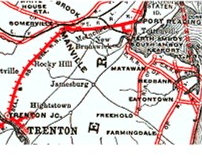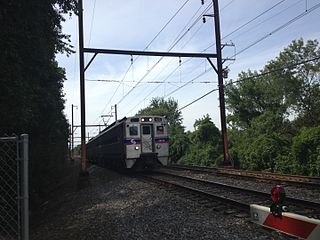
The Reading Company was a Philadelphia-headquartered railroad that provided passenger and freight transport in eastern Pennsylvania and neighboring states from 1924 until its acquisition by Conrail in 1976.
Conrail Shared Assets Operations (CSAO) is the commonly used name for modern-day Conrail, an American railroad company. It operates three networks, the North Jersey, South Jersey/Philadelphia, and Detroit Shared Assets Areas, where it serves as a contract local carrier and switching company for its owners, CSX Transportation and the Norfolk Southern Railway. When most of the former Conrail's track was split between these two railroads, the three shared assets areas were kept separate to avoid giving one railroad an advantage in those areas. The company operates using its own employees and infrastructure but owns no equipment outside MOW equipment.

The SEPTA Regional Rail system is a commuter rail network owned by SEPTA and serving the Philadelphia metropolitan area. The system has 13 branches and more than 150 active stations in Philadelphia, Pennsylvania, its suburbs and satellite towns and cities. It is the sixth-busiest commuter railroad in the United States, and the busiest outside of the New York, Chicago, and Boston metropolitan areas. In 2016, the Regional Rail system had an average of 132,000 daily riders and 118,800 daily riders as of 2019.
The National Railway or National Air Line Railroad was a planned air-line railroad between New York City and Washington, D.C. in the United States around 1870. Part of it was eventually built from New York City to Philadelphia by the Delaware and Bound Brook Railroad and the Delaware River Branch of the North Pennsylvania Railroad, leased by the Philadelphia and Reading Railway, in 1879, and becoming its New York Branch. The line was intended to provide an alternate to the various monopolies that existed along the route, specifically the United New Jersey Railroad and Canal Companies and their Camden and Amboy Railroad, and as such had a long struggle to be built.

Jenkintown–Wyncote station is a major SEPTA Regional Rail station along the SEPTA Main Line in Montgomery County, Pennsylvania. It is located at the intersection of Greenwood Avenue and West Avenue on the border of Jenkintown borough and the Wyncote neighborhood of Cheltenham Township, with a mailing address in Jenkintown. It is the ninth-busiest station in the regional rail system, and the fourth busiest outside Center City. Despite this, the station is not wheelchair accessible. SEPTA had plans to make the station wheelchair accessible by 2020, but these have not yet been completed.

The Port Reading Railroad was a railway company in the United States. It was incorporated in 1890 and completed its main line in 1892. It was controlled throughout its corporate life by the Reading Company. The Port Reading Railroad's line was conveyed to Conrail in 1976, and is today the Port Reading Secondary.
North Pennsylvania Railroad was a railroad company which served Philadelphia, Montgomery County, Bucks County and Northampton County in Pennsylvania. It was formed in 1852, and began operation in 1855. The Philadelphia and Reading Railway, predecessor to the Reading Company, leased the North Pennsylvania in 1879. Its tracks were transferred to Conrail and the Southeastern Pennsylvania Transportation Authority (SEPTA) in 1976.

The Connecting Railway was a subsidiary of the Pennsylvania Railroad, incorporated to build a connection between the Philadelphia and Trenton Railroad and the PRR in the city of Philadelphia.

Neshaminy Falls station is a station along the SEPTA West Trenton Line to Ewing, New Jersey. It is located at Bristol Road & Linden Street in Bensalem Township, Pennsylvania. The station has off-street parking and a handicapped-accessible platform. In FY 2013, Neshaminy Falls station had a weekday average of 276 boardings and 259 alightings.

Yardley station is a SEPTA Regional Rail station in Yardley, Pennsylvania. It is located at Main Street and Reading Avenue and serves the West Trenton Line to New Jersey. The station has off-street parking. In FY 2017, Yardley station had a weekday average of 349 boardings and 328 alightings. By August 2015, as a result of the SEPTA and CSX separation between Woodbourne and West Trenton stations, the outbound platform was removed, and all SEPTA traffic was diverted onto the Inbound track. Currently, all SEPTA service between Yardley and West Trenton operates on the Inbound track only.

The Trenton Subdivision is a railroad line owned by CSX Transportation in the U.S. states of Pennsylvania and New Jersey. The line runs from CP NICE in Philadelphia, Pennsylvania, northeast to Port Reading Junction in Manville, New Jersey. The line was formerly part of the Reading Company system.
The Philadelphia, Newtown and New York Railroad was a railroad in southeastern Pennsylvania that is now a part of the SEPTA commuter rail system as the Fox Chase Branch. Despite the name, it only ever extended between Philadelphia and Newtown, Pennsylvania.

The Crusader was a 5 car stainless steel streamlined express train that ran on a 90.3-mile (145.3 km) route from Philadelphia's Reading Terminal to Jersey City's Communipaw Terminal, with a ferry connection to Lower Manhattan at Liberty Street. The Reading Railroad provided this service in partnership with the Central Railroad of New Jersey (CNJ), in which it was the majority owner of capital stock. Trains including the Crusader ran on Reading Railroad tracks from Reading Terminal in Philadelphia to Bound Brook, NJ, where they continued on CNJ tracks to Communipaw Terminal in Jersey City. Passengers then left the train and walked aboard the ferry or boarded busses that loaded onto the ferry. Introduced in 1937, the Crusader service declined during the 1960s, and the name was ultimately dropped in 1981.

The West Trenton Line is a SEPTA Regional Rail service connecting Center City Philadelphia to the West Trenton section of Ewing Township, New Jersey.

The Lehigh Line is a railroad line in Central New Jersey, Northeastern Pennsylvania, and the Lehigh Valley region of eastern Pennsylvania. It is owned and operated by the Norfolk Southern Railway. The line runs west from the vicinity of the Port of New York and New Jersey in Manville, New Jersey via Conrail's Lehigh Line to the southern end of Wyoming Valley's Coal Region in Lehigh Township, Pennsylvania.
The Main Line of the Reading Company was a railway line in the U.S. state of Pennsylvania. The 88-mile-long (142 km) main line ran from Philadelphia to Pottsville, Pennsylvania, following the Schuylkill River.
The Wilmington and Northern Branch is a partially-abandoned railway line in the states of Delaware and Pennsylvania. It was constructed between 1869 and 1870 by the Wilmington and Reading Railroad, a predecessor of the Wilmington and Northern Railroad. At its fullest extent it connected Reading, Pennsylvania, with Wilmington, Delaware. The Philadelphia and Reading Railway leased the line in 1900. With the Reading Company's bankruptcy and the creation of Conrail in 1976 the line's ownership fragmented, and the section between Coatesville, Pennsylvania, and Birdsboro, Pennsylvania, has been abandoned.

The Neshaminy Line is a railway line in the states of Pennsylvania and New Jersey. It runs 21.7 miles (34.9 km) from a junction with the SEPTA Main Line just north of Jenkintown–Wyncote to West Trenton, just across the Delaware River. It was originally built in 1876 as part of the much longer New York Branch, which continued north to Bound Brook, New Jersey. The electrified section between Jenkin and West Trenton was designated the Neshaminy Line and is now owned by SEPTA. It hosts the West Trenton Line commuter rail service. The freight-only Trenton Subdivision runs parallel between Neshaminy Falls and West Trenton.
The Fox Chase Branch, formerly the Newtown Branch, is a railway line in the state of Pennsylvania. It runs 4.9 miles (7.9 km) from a junction with the SEPTA Main Line near Wayne Junction to Fox Chase. At its fullest extent, it continued another fifteen miles north to Newtown. The oldest part of it was built in 1876 by the Philadelphia, Newtown and New York Railroad. It was part of the Reading Company system from 1879 until 1976. Today it is owned by SEPTA and hosts the Fox Chase Line commuter rail service.
The New York Short Line was a railway line in Pennsylvania. It was operated by the Reading Company and built by the New York Short Line Railroad, a subsidiary. It was opened in 1906 to provide a more direct route between Philadelphia and New York City, bypassing the existing route via Jenkintown. The line was conveyed to Conrail in 1976 and is now part of the Trenton Subdivision of CSX.












